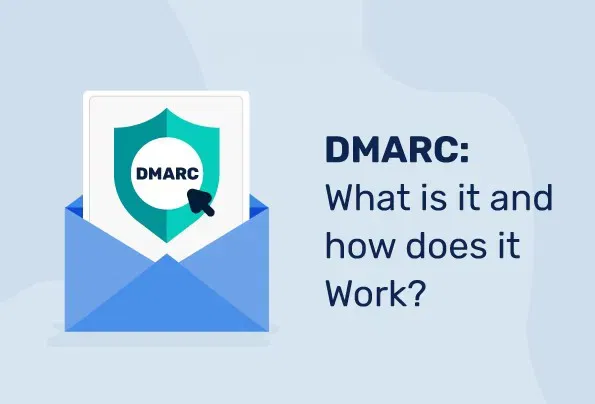Guide To DMARC
Understanding DMARC: A Game-Changer in Email Security

Reading Time: 8 min
DMARC (Domain-based Message Authentication, Reporting, and Conformance) is an essential protocol designed to safeguard businesses from phishing and email spoofing attacks. Cybercriminals often exploit email systems by impersonating legitimate domains, leading to financial loss, data breaches, and reputational damage. In the first quarter of 2022 alone, the Anti-Phishing Working Group (APWG) recorded over 1 million phishing attacks.
Without DMARC, even your legitimate emails might end up in spam folders, affecting email deliverability. This guide will help you understand DMARC, its importance, benefits, and how to implement it to secure your domain.
Secure Your Email
Stop Email Spoofing and Improve Email Deliverability
15-day Free trial!
Latest Blogs
How to Add Your Logo to Gmail Emails: Gmail & Branded Emails
July 2, 2024 - 12:50 am
What Are the Cybersecurity Threats When Allowing Third-Party Cookies on Mac?
June 29, 2024 - 1:38 pm
DMARC: The Missing Link in Your MSP’s Defense Strategy
June 27, 2024 - 11:16 am
GoDaddy SPF, DKIM, and DMARC Record Configuration Guide: Step-By-Step
June 26, 2024 - 1:00 pm
What is DMARC?
DMARC is an email authentication protocol that helps domain owners prevent unauthorized use of their domain in email communications. By defining policies for message verification and handling, DMARC helps organizations combat phishing and email fraud.
DMARC builds upon SPF (Sender Policy Framework) and DKIM (DomainKeys Identified Mail) protocols to verify the authenticity of an email. If an email fails DMARC verification, domain owners can choose to reject, quarantine, or allow its delivery. DMARC policies are configured at the DNS level.
Breaking Down DMARC
DMARC Full Form
DMARC stands for Domain-based Message Authentication, Reporting, and Conformance. Here’s how it functions:
- Domain-based: Operates at the domain level.
- Message Authentication: Uses SPF and DKIM protocols to verify emails.
- Reporting: Sends reports on email activity to the domain owner.
- Conformance: Defines how mail servers handle emails that fail DMARC authentication.
How Does DMARC Work?
When an email is sent, the receiving mail server checks if it aligns with SPF and DKIM records stored in the domain’s DNS.
- If an email passes either SPF or DKIM checks, it is considered DMARC-compliant.
- If both checks fail, the email fails DMARC verification.
- Based on the domain’s DMARC policy, the email can be rejected, quarantined, or delivered.
- DMARC reports help domain owners track unauthorized email activities and potential spoofing attempts.


Why is DMARC Important?
Email authentication mechanisms like spam filters are not enough to prevent domain spoofing. Attackers often impersonate trusted brands to trick users into revealing sensitive information. According to IBM’s Cost of a Data Breach Report, 19% of data breaches result from compromised credentials.
Key Benefits of DMARC:
- Enhances email security by preventing spoofing.
- Protects brand reputation by ensuring only legitimate emails reach recipients.
- Improves email deliverability by reducing spam rejections.
- Mandatory for compliance with Google, Yahoo, and PCI-DSS email policies.
- Supports BIMI (Brand Indicators for Message Identification), allowing businesses to display logos in authenticated emails.
How to Enable DMARC for Your Domain?
Step 1: Assess Your Email-Sending Infrastructure
Identify all platforms and tools that send emails on your behalf, such as marketing automation services, customer support platforms, and third-party email providers.
Step 2: Configure SPF and DKIM Records
Ensure your domain has valid SPF and DKIM records. You can use online generators to create SPF and DKIM records, then publish them in your domain’s DNS settings.
Step 3: Create a DMARC TXT Record
Using a DMARC record generator, define a DMARC record with the required parameters:
- v=DMARC1 (protocol version)
- p=none/quarantine/reject (policy mode)
- rua=mailto: (email address for aggregate reports)
- ruf=mailto: (email address for forensic reports)
Step 4: Publish Your DMARC Record in DNS
Access your DNS management console and create a new TXT record with _dmarc as the hostname.
Step 5: Monitor and Adjust DMARC Policy
Start with a p=none policy to collect reports, then move to quarantine or reject for stricter security.
Step 6: Verify DMARC Implementation
Use a DMARC checker tool to validate your DMARC setup.
What Does a DMARC Record Look Like?
A DMARC TXT record example:
_dmarc.example.com. IN TXT "v=DMARC1; p=reject; rua=mailto:dmarc@example.com; ruf=mailto:forensics@example.com; sp=reject"
Components Explained:
- v=DMARC1: Specifies DMARC version.
- p=reject: Emails failing DMARC checks will be rejected.
- rua=mailto:dmarc@example.com: Receives aggregate reports.
- ruf=mailto:forensics@example.com: Receives forensic reports.
- sp=reject: Applies policy to subdomains as well.
DMARC, SPF, and DKIM – The Pillars of Email Authentication
SPF (Sender Policy Framework):
SPF verifies that an email is sent from an authorized IP address by checking DNS records.
DKIM (DomainKeys Identified Mail):
DKIM digitally signs emails using a cryptographic signature to verify the sender's identity.
Enhance Your Email Security with PowerDMARC
PowerDMARC offers a cloud-based DMARC solution, simplifying DMARC implementation and monitoring. Sign up for a 15-day free trial to enhance email security and prevent domain spoofing.
